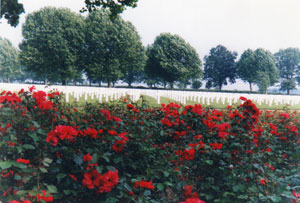HOLTEN, THE NETHERLANDS - A young Dutch girl patiently rearranges a tiny white cross that a cool March wind has toppled in front of a soldier's grave. The breeze whistles through the surrounding forest and plays havoc with the flowers two of her classmates are trying to plant in the sacred soil.
Myrte van Geerestein, 12, Wout van Zoelen, 11, and Paul Aaftink, 12, are not much younger than the mostly 20-year-olds buried beneath the perfectly manicured lawns of the Canadian war cemetery here.
They giggle as a visitor asks to take their photographs. Their youthful laughter brings life to this place where 1,355 Canadians are honoured in death.
Once a year, Canadians collectively pause to remember the ultimate sacrifice their compatriots paid on the battlefields of Holland, the rest of Europe, and Asia during two world wars.
Here, the Dutch remember every day.
The local school children make regular pilgrimages to the cemetery, which was donated to Canada by the Dutch people, and twice a year - May 4 and December 24 - take part in more elaborate ceremonies to honour the Canadians and the 39 other Allied soldiers (36 British, 2 Australians and 1 Belgian) who rest beside them.
"The soldiers are never alone," said Gert Jan van't Holt, the former headmaster of the nearby Haarschool where the three children attend classes. "Canadian tourists come here regularly and the town's people pay their respects often.
"On May 4, which is our Remembrance Day, the local school children assemble here and read poems to the soldiers.
And on December 24, they light a candle on top of each of the gravestones and sing to the soldiers."
As part of their school curriculum, every child here must learn the words to O Canada and are taught about Canada's contribution to their freedom.
Only 13 of the Canadian soldiers buried here actually died defending this neatly kept little town located not far from Appledorn.
The rest were brought here from various battlefields around the Netherlands.

Above: No one honours war dead more than dutch.
"The bodies of the fallen soldiers were buried in shallow graves in local gardens after each battle and a detail marked each with a white cross. General G.G. Simonds, commander of the 2nd Canadian Army, chose Holterberg - this hill just outside Holten - as the final resting place for his men. The bodies were collected and brought here," said van 't Holt.
The tradition of school children caring for the graves actually started in the 1950s, when each grave site was adopted by a local family.
"Some of the graves were cared for more than others and the Commonwealth Graves War Committee (the group that administers war graves) wanted them all to look the same. So they took over the caring of the cemetery and hired a fulltime caretaker and today each is exactly the same," said van 't Holt.
Well, not every one. On top of one gravestone engraved with the Star of David and containing the remains of H.J. Bockner, who like most of his comrades buried alongside him died in a battle on April 11, 1945, rest three tiny pebbles.
The old schoolmaster smiled as he related a story concerning the three smooth stones.
"For some time, our caretaker would arrive each morning and find the stones on graves containing the remains of Jewish soldiers. He thought some local kids had put them there as a prank so he would brush them off. Then one day a woman saw him doing that and asked why. She then proceeded to tell him the three stones were significant in the Jewish religion and represented tears turning to stone. 'They were put there to show sorrow,' she told the caretaker. He never brushed them away again," said van 't Holt.
Each of the graves is marked with a cross or Star of David - or nothing.
"It was left to the families how they wanted to mark the graves," said van 't Holt. Five of the graves have no names - unknown soldiers all.
After World War II, the people of Holten started a poppy fund and the townspeople collected enough money to bring the families of the fallen soldiers here to pay their final respects.
There are 44 local committees that look after the cemetery and they are all working toward a major celebration in 2005 to mark the 60th anniversary of the end of World War II.
"It will be the last major ceremony honouring those who fought here," said a saddened van 't Holt, recognizing the advancing years of the surviving veterans.
The eerie quiet of the cemetery, where different varieties of heather grow at various times of year so a floral presence is always prominent here, is shattered by the arrival of a larger group of high school students. Half are Dutch but the rest speak German.
Mike Battes, a young Dutchman with Hollywood good looks, told us the German students are from a school just across the border.
"They are here to learn about what sacrifices the Canadians made. They (the Germans) don't have military cemeteries like this so they are intrigued to see how many gave up their lives for freedom," continued Battes, who joyfully predicted: "One day I will be Holland's first Hollywood movie star."
One wonders just how many of those buried here had similar youthful aspirations.
About the Author
Marc Atchison is a veteran journalist and a seasoned traveller with more than 20 years of travel writing experience. As the former Travel Editor of the Toronto Star, Canada's largest newspaper, and now Editor-in-Chief and Senior Writer for TraveLife magazine (Canada) and travelife.ca, Marc has been to over 100 countries in the world. Japan is one of his favorite destinations and he's been there on numerous occasions.